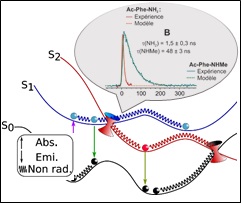|

Non-radiative deactivation
mechanisms in bio-relevant systems | |
 |
Electronic dynamic of bio-relevant systems: a dual experiment-theory approach
While the absorption of light by biomolecules is ubiquitous in Nature and used in many fields of research, the understanding of the underlying ultrafast process following the photon absorption is still limited. In this project, conformer-selective excited state dynamics of bio-relevant systems (isolated and hydrated peptides, or model complexes for chiral recognition) have been investigated through a synergetic experimental/theoretical approach. An original multi-step and multi-level theoretical strategy to efficiently and accurately model the excited states potential energy surfaces of these systems have been developed. In parallel, novel experimental procedures coupling the measure of excited state dynamics by nano-, pico and femtochemistry techniques with the conformer-selectivity brought by IR spectroscopy or its variant in helium droplets have been implemented. By unraveling the mechanisms at play after the absorption of a photon, this project document how the electronic energy is finally used (isomerization, chemical reaction) or released (light emission, thermal conversion), processes of paramount importance in many field of applied research.
Conformer-selective laser spectroscopies (IR-UV/UV, IR in helium droplet) and nonadiabatic dynamics simulations (Excited state and conical intersection)
As the low-lying excited states of different nature of these systems need to be described simultaneously in a balanced and accurate way, an innovative theoretical approach has been developed. First, non-adiabatic dynamic simulations based on time-dependent density functional theory (TDDFT) have been performed to provide hints about the critical motions driving the deactivation. Second, the pathways have been then investigated at a better level of theory with the standard coupled cluster method to second order (CC2). Finally, in order to validate the standard method, an original multireference wavefunctions method in localized orbitals has been extended and applied to these systems. From the experimental side, the IR/UV double resonance and time-resolved UV/UV spectroscopies are used to obtain crossed-checked information about structure and dynamics. Beyond the nano- and picosecond regimes, exploratory studies at the femtosecond regime were conducted to treat ultra-short-lived excited states. Besides, for non-ionizable conformers by nanosecond UV pulse, IR spectroscopy in helium droplets has been developed and applied to a series of flexible molecules in order to detect the whole conformational population.
Major results of the project:
Developed on small peptides, the innovative computational strategy combining non-adiabatic dynamics simulations and mono-/multireference methods is now applied to model efficiently low-lying excited states potential energy surfaces of larger peptides, hydrated ones and model complexes for chiral recognition. The experimental setup, IR spectroscopy in helium droplets, have been extended to the bio-relevant systems and is now operational. On the other hand, the development of IR/UV double resonance spectroscopy at the femtosecond regime is still ongoing. However, a non-excepted setup giving the IR spectra of excited states have been implemented.
Scientific production of the project:
This project has so far resulted in 9 publications and an article of vulgarization. In addition, 1 publication is submitted, 3 are to be submitted and 4 are in preparation. A website dedicated to this project has been implemented and has been operational since July 2016 (http://iramis.cea.fr/meetings/ESBODYR/index .php). Furthermore, the progress and results of this project were presented at 13 invited conferences, 9 oral presentations and 13 posters. Finally, 23 acts of diffusion were produced (3 reports of stage M2 and 20 seminars).
Factual information: The ANR-14-CE06-0019 project is a basic research project coordinated by V. Brenner (LIDYL / SBM, CEA-CNRS UMR9222). It also associates the LIDYL / DyR team, as well as two partner laboratories, the LCPQ (UMR5626, Scientist. Resp.: Sophie Hoyau) and the ISMO (UMR8214, Scientist Resp.: Anne Zehnacker). The project started in October 2014 and lasted 48 months. It benefited from ANR assistance of € 470000 for an overall cost of around € 2.6 million (full cost). This project was the subject of an annual request for hours of calculations on the national resources via the TGIR GENCI (CCGT / CCRT-CINES-IDRIS) and on the centralized means of the CEA (CCGT / CCRT) accounting for four years a number of hours of 1.6 MH.
|

